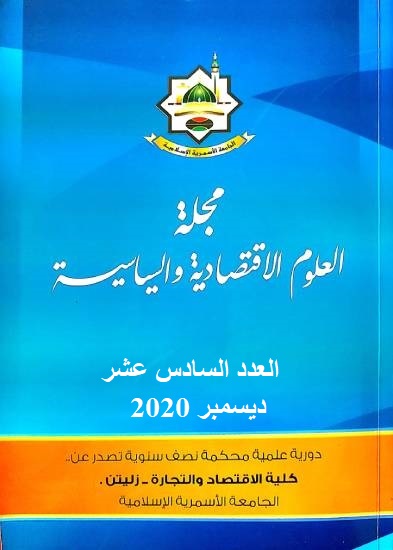قياس وتحليل العلاقة بين تجارة ليبيا الخارجية والنمو الاقتصادي باستخدام نموذج الإنحدار الذاتي للإبطاء الزمني الموزع ( ARDL )
الكلمات المفتاحية:
الصادرات، الواردات، النمو الاقتصادي، التكامل المشترك، ARDLالملخص
إن التجارة الخارجية تمثل شريان الحياة بالنسبة للاقتصاد الليبي اذ يعتمد على عوائد الصادرات النفطية لتمويل عملية التنمية الاقتصادية وكذلك لتمويل استيراد السلع الاستهلاكية والاستثمارية والوسيطة ومن هذا الجانب تم اختيار هذا الموضوع لدراسته وتحليله حيث برزت أهمية البحث في تحليل تجارة ليبيا الخارجية والنمو الاقتصادي خلال الفترة (1962-2014) وهي محاولة لتحديد العلاقة التوازنية قصيرة الأجل وطويلة الأجل بين هذين المتغيرين حيث تم استخدام نموذج ARDL لتفسير العلاقة الاقتصادية بين المتغيرين ولتحقيق أهداف البحث فقد تم تقدير النموذج القياسي بعد اختبار مدى استقراريه السلاسل الزمنية للمتغيرات الاقتصادية والتحقق من وجود علاقة تكامل مشترك بين هذه المتغيرات وتحقيقا لأهداف البحث فقد تم تقسيمه الى محورين الاول تناول مفهوم التجارة الخارجية والنمو الاقتصادي والثاني تناول قياس وتحليل العلاقة بين المتغيرات الاقتصادية المستخدمة وقد توصل البحث الى انه هناك علاقة توازنيه قصيرة وطويلة الأجل بين كل من التجارة الخارجية والنمو الاقتصادي وهو يتفق مع اهداف البحث.
المراجع
- العلاوي كمال، شاكر اسعد، (2016)، "العلاقة السببية بين التجارة الخارجية والنمو الاقتصادي في العراق خلال المدة (1920-2013)، مجلة الغربي للعلوم الاقتصادية والادارية، 13 (40): 4.
- ساحة خالد، (2010)، التجارة الدولية النظرية وتطبيقاتها، عالم الكتب الحديث، اربد، الاردن، الطبعة الاولى، ص206.
- الختلان خالد، (2009)، إشكالية العلاقة بين الصادرات الاولية والنمو الاقتصادي في الدول الاخذة بالنمو (التطبيق الاحصائي على المغرب باستخدام OLS)، المجلة العلمية للاقتصاد والتجارة، العدد الاول، جامعة عين شمس، 35-67.
- مهني مريم، (2016)، "العلاقة بين الصادرات والنمو الاقتصادي، دراسة نظرية تحليلية في ليبيا (1980-2010) "أماراباك، مجلة الاكاديمية الامريكية العربية للعلوم والتكنولوجيا، 7 (2): 65-66.
- ابوجامع جابر، (2016) "أثر التجارة الخارجية على النمو الاقتصادي والتنمية في فلسطين، (1995-2014) "، مجلة جامع النجاح للأبحاث (العلوم الإنسانية) 30 (9): 1847.
- عبدالرزاق، محمود، (2010)، الاقتصاد الدولي والتجارة الخارجية، ط1، الدار الجامعية الاسكندرية.
- بلقاسم، زايري، (2013)، اقتصادات التجارة الدولية، ط1، ابن النديم للنشر والتوزيع، بيروت.
- نمر، صديقي، (2009)، التحليل الاقتصاد الكلي بين النظرية والتطبيق، جامعة قاصدي، الجزائر.
- Shirazi, N. S. & Manap, T.A.A. (2004). Export-Led Growth Hypothesis: Further Econometric Evidence from Pakistan. Pakistan Development Review, 43, 563-581.
- Thurayia, S. (2004). The Relationship between Exports and Economic Growth Experience of Saudi Arabia and the Republic of Sudan. Economic Studies, the Scientific Series of the Saudi Economic Association, V6, A11.
- Mah, J. S. (2005). Export Expansion, Economic Growth and Causality in China. Applied Economic Letters, 12. 105-107.
- Tang, T. C. (2006). New Evidence on Export Expansion, Economic Growth and Causality in China. Applied Economics Letters. (13). 801- 803.
- Ullah, Zaman, Farooq & Javid. (2009). Cointegration and Causality between exports and Economic Growth in Pakistan. European Journal of Social Sciences, 10(2). 264-272.
- Elbeydi, K. R. M. Hamuda, A. M. & Gazda, V. (2010). The Relationship between Export and Economic Growth in Libya Arab Jamahiriya. Theoretical and Applied Economics, Volume XVII(2010), No. 1(542). 69-76.
- Mishra, P. K. (2011). The Dynamics of Relationship between Exports and Economic Growth in India. International Journal of Economic sciences and Applied Research, 4(2). 53-70.
- Khan, D.A. Umar, M.A. Zaman, N. Ahmed, E. & Shoukat, Y. (2012). Exports, Imports and Economic Growth Nexus: Time Series Evidence from Pakistan, World Applied Science Journal, 18(2). 538- 542.
- Grabowski, R., Sharma, S.C. and Dhakal, D. (1990). Exports and Japanese economic development, Economics Letters, Vol. 32, p. 127- 132.
- Dodaro, Santo. (1991). Comparative Advantage, Trade and Growth: Export-Led Growth Revisited, World Development, Vol. 19, N.9,p. 1153-1165.
- Gerber , James , (2014) , International Economic , Inc.
التنزيلات
منشور
إصدار
القسم
الرخصة
الحقوق الفكرية (c) 2020 مجلة العلوم الاقتصادية والسياسية

هذا العمل مرخص بموجب Creative Commons Attribution 4.0 International License.





